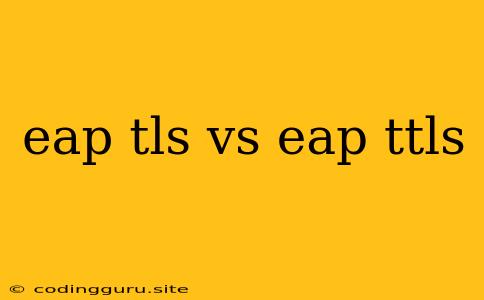EAP-TLS vs. EAP-TTLS: Which is Right for Your Network?
When it comes to securing wireless networks, EAP-TLS and EAP-TTLS are two popular options that offer robust authentication and encryption. While both protocols are effective, they differ in their implementation and security features, leading to varying levels of complexity and cost. This article will delve into the specifics of each protocol, comparing and contrasting their features to help you determine which one is best suited for your network.
What is EAP-TLS?
EAP-TLS (Extensible Authentication Protocol - Transport Layer Security) is a strong authentication mechanism that leverages digital certificates for both the server and the client. It utilizes the robust TLS (Transport Layer Security) protocol for secure communication, ensuring data confidentiality and integrity.
How it works:
- The client requests authentication to the network.
- The server sends a certificate to the client for verification.
- The client verifies the server's certificate against a trusted root CA.
- The client presents its own certificate for authentication.
- The server verifies the client's certificate and grants access to the network.
What is EAP-TTLS?
EAP-TTLS (Extensible Authentication Protocol - Tunneled Transport Layer Security) is a similar protocol to EAP-TLS but utilizes an additional layer of security. While EAP-TLS uses TLS directly, EAP-TTLS employs a TLS tunnel to secure the communication between the client and the authentication server.
How it works:
- The client requests authentication to the network.
- The server establishes a TLS tunnel with the client.
- Inside the TLS tunnel, the client authenticates using a chosen inner method, such as PAP, CHAP, or MSCHAPv2.
- The server verifies the client's credentials and grants network access.
Comparing EAP-TLS and EAP-TTLS
| Feature | EAP-TLS | EAP-TTLS |
|---|---|---|
| Security | Very strong, using TLS directly | Strong, using TLS tunnel |
| Complexity | More complex, requires certificates for both client and server | Less complex, only requires certificates for the server |
| Cost | Higher, requires certificate management | Lower, simpler certificate management |
| Flexibility | Less flexible, only uses TLS | More flexible, allows for various inner authentication methods |
| Client Support | Widely supported | Widely supported |
Advantages of EAP-TLS
- Strongest security: EAP-TLS offers the highest level of security due to the direct use of TLS, providing robust encryption and authentication.
- Mutual authentication: Both the client and server authenticate each other, reducing the risk of man-in-the-middle attacks.
- No password sharing: Passwords are not transmitted over the network, increasing security.
Disadvantages of EAP-TLS
- Complexity: EAP-TLS requires certificates for both the server and each client, which can be a complex process.
- Cost: Certificate management for numerous clients can be expensive, as it often requires third-party services.
- Scalability: Implementing EAP-TLS for large networks can be challenging and time-consuming.
Advantages of EAP-TTLS
- Simplified certificate management: Only the server requires a certificate, simplifying the process.
- Flexibility: EAP-TTLS allows the use of different inner authentication methods, providing more flexibility.
- Lower cost: Certificate management for only the server is less expensive than for both client and server.
Disadvantages of EAP-TTLS
- Reduced security: EAP-TTLS uses TLS only to secure the tunnel, leaving the inner authentication method vulnerable.
- Potential for attacks: If the inner authentication method is weak, the entire system can be compromised.
Which protocol to choose?
The choice between EAP-TLS and EAP-TTLS depends on your specific network requirements and security priorities:
- Choose EAP-TLS if:
- You need the highest level of security and are willing to invest in certificate management.
- You have a small to medium-sized network with manageable certificate requirements.
- Choose EAP-TTLS if:
- You prioritize ease of implementation and lower cost.
- You are comfortable with using a less secure inner authentication method within the TLS tunnel.
- You have a large network where certificate management for each client would be too complex.
Examples
EAP-TLS is commonly used in enterprise networks where security is paramount, such as banks, government agencies, and healthcare facilities. EAP-TTLS is often chosen for smaller networks or where certificate management for each client is impractical.
Conclusion
Both EAP-TLS and EAP-TTLS are effective authentication protocols, offering robust security and flexibility. EAP-TLS provides the highest level of security but comes with higher complexity and cost. EAP-TTLS offers a more streamlined approach but compromises some security in favor of ease of implementation and lower cost. Ultimately, the best choice depends on your specific network needs and security requirements.
